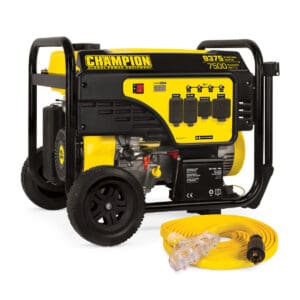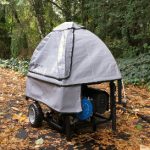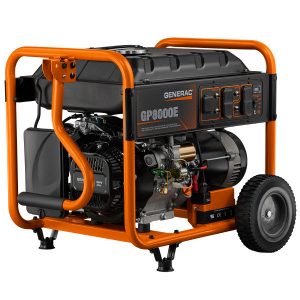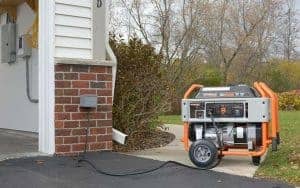What Will a 7500 Watt Generator Power

The power capacity of different portable generator models varies as widely as the appliances they power. If the power goes out, you are probably less concerned that your electric stove doesn't have power than you are about the basement flooding because your sump pump doesn't work.
The length of time the power is out and the time of year may also affect which appliances you choose to supply with emergency power from your portable generator. The power output capacity of a generator determines what it can power. It is up to you to decide what appliances to supply with electricity in the event of an outage.
Need a Portable Right Away? Norwall Can Ship from Stock Today
Power Outages often occur during bad weather. Many first time buyers don't realize that most portable generators need protection from rain, snow, and ice, but generators cannot run indoors because the engine creates deadly carbon monoxide. Toxic levels of the odorless, colorless gas accumulate quickly and too often kill.

To overcome the problems presented by running a portable generator in wet conditions, GenTent Generator Canopies invented the Portable Generator Canopy. The frame clamps to the generator frame and the canopy covers the generator to allow operation in nearly any kind of wet weather.
GenTent Portable Generator Canopies
Understanding Power Output

Power is measured in Watts (W) or in Kilowatts(kW). One kilowatt equals 1000 watts. Calculate Watts by multiplying voltage by amperes. A device that runs on 120 volts and draws 5 amperes uses 600 watts (120V x 5A) of power. On some appliance tags, this is expressed as Volt-Amps or VA; others express their power requirements in watts or kilowatts.
Appliances require a certain amount of power, regardless of the voltage level they are designed to run on. At 240 volts, a 600-watt appliance only requires 2.5 amperes of current, but another 600-watt appliance operating at 120 volts needs twice as many amperes—5 amps. Generator Capacity is rated in watts or kilowatts because it is the power that matters, not the voltage.
Generators have two power ratings; maximum or surge power and continuous power. Continuous power refers to the number of watts or kilowatts the generator is able to supply continuously without overloading. Maximum or surge power is a higher output that lasts just a few seconds for starting motors. At startup, motors require two to six times more power than their continuous power requirement. A generator must provide this surge of power for for several seconds without overloading.
Typical Appliance Power Requirements
The following table lists typical power requirements for starting and running some common appliances. Actual power requirements may vary by manufacturer, motor size and type of motor used. Only running watts apply to appliances without motors. Visit our Portable Generator Sizing Guide for help choosing the right generator to fit your needs.
View Power Expert Page
Appliance Power Requirements
| Appliance | Running Watts | Starting Watts |
|---|---|---|
| Sump Pump 1/2 HP | 1050 | 3200 |
| Well Pump 1 HP | 2000 | 6000 |
| Refrigerator | 700 | 2100 |
| Freezer | 700 | 2100 |
| Furnace 3/5 HP Fan | 875 | 2625 |
| Window Air Conditioner 6,000 BTU | 900 | 2700 |
| Window Air Conditioner 12,000 BTU | 1700 | 5100 |
| Coffee Maker | 1200 | |
| Toaster Oven | 1550 | |
| Hot Plate | 1200 | |
| Electric Frying Pan | 1200 | |
| Microwave Oven 1,000 Watt | 1000 | |
| Electric Lights* | Printed on Bulb* |
*Energy efficient bulbs are often compared to their incandescent counterparts. Use the actual bulb wattage and not the incandescent wattage.
Managing Portable Generator Power

Decide which critical appliances should receive power during an outage. Give top priority to sump pumps, sewage pumps, refrigerators and freezers. Add the furnace to your list in cold weather to keep the house warm and prevent pipes from freezing. Total the running watts for all the appliances that will run at the same time, then add the highest starting watts to the total. Calculate running watts for motors by multiplying running watts by three.
Some heavy duty motors may require six times the running watts to start.
Manage power by only starting one critical appliance at a time. Start the largest loads first and work your way down to the lighter loads. Operate loads in cycles. During heavy rain, you might need your sump pump going full time, but if it's dry, then maybe it won't run at all.

Warning: Never attempt to connect a portable generator to a home by plugging it into an appliance or convenience outlet. Backfeeding is dangerous and illegal in many jurisdictions.
A manual transfer switch is the safest and most efficient way to supply a home from a portable generator. Not only does it make power management easier, they also power appliances that don't have power cords such as furnaces and well pumps. Most importantly, they isolate your home and prevent the portable generator from back-feeding the utility lines―a serious danger to utility workers attempting to restore power.
Portable Generator Safety
- The first priority is safety while operating a portable generator.
- Position the portable generator at least 20 feet away from the home.
- A Manual Transfer Switch is the safest connection to the home.
- Never operate a portable generator indoors.
- Use a Carbon Monoxide ( CO ) detector inside the home.
- Never backfeed your home from a portable generator.
- Use heavy duty extension cords rated for the current they will carry.
- Protect portable generators from weather with a GenTent Generator Canopy.
Consider a standby generator as a permanent, automatic source of emergency backup power. They don't require refueling. They start and run automatically during an outage, even when you're on vacation or away on business. You won't have to go outside and position, make electrical connections, and start a portable generator in the middle of a storm.
Updated: September 12, 2018
* Sizing Guides are intended for estimating purposes only. Actual power requirements of high demand appliances vary widely by brand, model and capacity. Always have an authorized dealer or qualified electrician analyze your specific requirements before making a purchase decision.
Become a Power Expert
What Will a 7500 Watt Generator Power
Source: https://blog.norwall.com/generator-tips/portable-generators/portable-generator-run-power-outage/
0 Response to "What Will a 7500 Watt Generator Power"
Post a Comment